We all like to think we know how to eat a healthy, well-balanced diet. But when it comes to children, making sure they are getting the right nutrients to help them grow up healthy and strong can be a big concern for many parents. This guide will cover the basics of nutrition and what a healthy diet looks like, to tips on how you can encourage healthy habits in your child.
Nutrition parenting guide contents:
Download FREE Nutrition Guide eBook
We all know that eating vegetables is important – the Australian Guidelines for Healthy Eating recommend five serves per day.
So how do you get our children to eat more vegetables?
Grow
Starting at the very beginning, before we even get vegetables onto the plate, learning to grow them has been demonstrated to increase a child’s willingness to try vegetables and increase their preference for consuming them. The process of planting and caring for seeds is an amazing way to engage your child in enjoying vegetables and reaping their benefits. Try starting small with carrots, Harold’s favourite!
Flavour
Children’s taste buds are constantly changing and developing, their taste senses are much more intense than adults. Learning what flavours your child enjoys can help you to offer vegetables they will enjoy eating. Remember to also take some time to learn about flavour pairings of vegetables to help make food taste more appealing to little tongues. Below is a vegetable flavour family to help identify tastes. Start with the green shaded flavours first and keep in mind some vegetables may belong to a few flavour profiles.
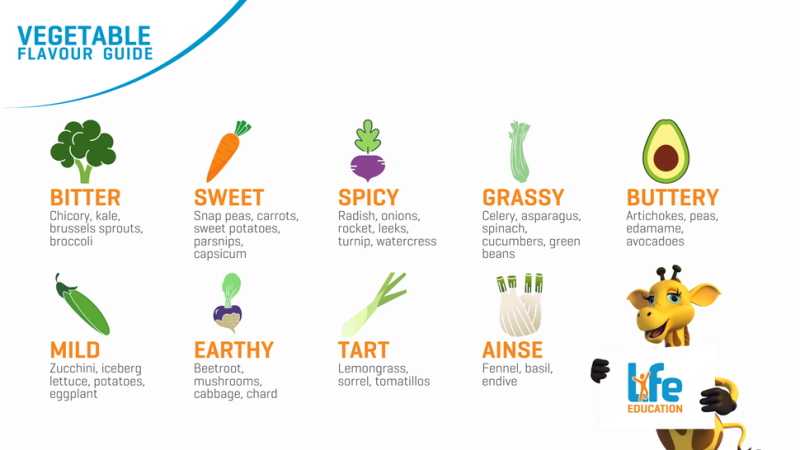
Spread
Most Australian children and adults consume most of their vegetable intake during dinner times, and most of us do not consume enough of our recommended daily intake of vegetables. Spreading your vegetable consumption throughout the day will expose your child to more vegetables and help to create a more balanced approach to eating. Here are some ways to incorporate vegetables into every mealtime:
Breakfast: Vegetable frittata, breakfast burrito, zucchini and carrot fritters
Lunch: Rice paper rolls, veggie pizza, veggie packed waffles
Dinner: Veggie noodle stir fry, zucchini lasagne, veggie burgers.
Snacks: Vegetable muffins, vegetable slice, crunchy veg and dip,
Special treats: Chocolate and beetroot cake, pumpkin and coconut muffins, chocolate zucchini slice.
Serve
Not only should you serve vegetables at every meal, but you should also ask your kids to help with serving them. Ask them to fill up their plates and your plate with what they think a healthy meal looks like. This will help start a conversation with your child as to why vegetables are important, help them become more mindful of what they are eating and expose them to a variety of different vegetables. If you are eating out, try to include a salad or side of vegetables for your child to serve around the table. This will help form healthy habits where vegetables at every meal becomes normal
Cut
Young children learn so much through their senses, especially through their little fingers that like to touch and play with everything. Encourage this exploration by cutting up vegetables into smaller pieces or different shapes for them to enjoy. You will be surprised the difference a crinkle vegetable cutter can make when it comes to sparking a child’s imagination and interest.
4 tips to help keep our immune system healthy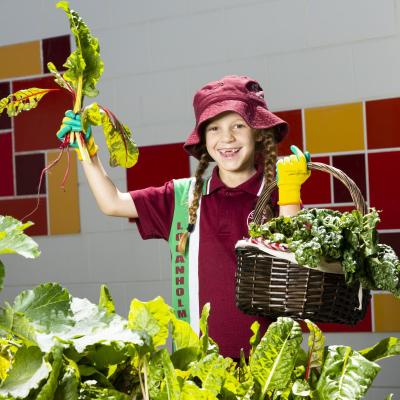
Packed with vitamins and minerals, disease-fighting antioxidants and fibre, all vegetables can be considered superfoods. So super, Australian Dietary Guidelines recommend five serves of vegetables each day!
If five serves seems like a lot, here’s five ways to add more veg to your day courtesy of tryfor5.org.au.
If you’re lacking motivation, remember vegetables can help you to maintain a healthy weight and lower cholesterol and blood pressure while protecting you against chronic diseases such as type 2 diabetes, heart disease, stroke and cancer.
Add diced veg to scrambled eggs or omelette e.g capsicum, spring onion, zucchini, mushrooms, spinach or tomato. Serve with rocket or spinach and a drizzle of extra virgin olive oil.
Grate a carrot or zucchini, or add some kidney beans or other legumes into any dish that includes mince, such as pasta sauces, burritos and tacos. The kids won’t even know!
Snack on veggie sticks such as celery, carrots, capsicum or cucumber, which can also be served with hommus, tzatziki or other vegetable-based dips.
For a yummy snack on-the-go, make some savoury scones or muffins, and include any veggies you have on hand. They can also be frozen and eaten later.
Try a green smoothie (spinach, broccoli, cucumber, carrot and ginger) or add vegetables (such as avocado, cucumber, lettuce or spinach) to fruit smoothies.
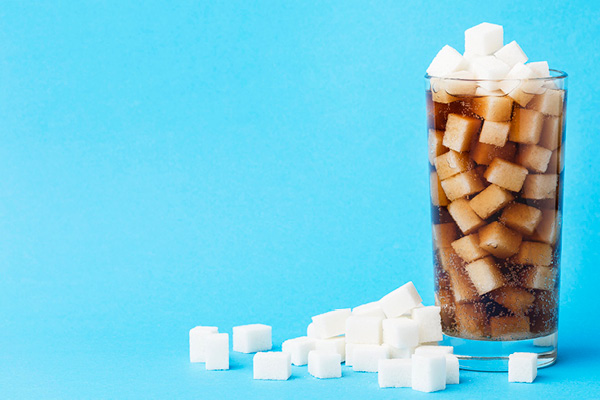 Soft, fizzy or carbonated drinks, whatever their name, as a community we know they aren’t the healthiest choices for our children – but do you know why?
Soft, fizzy or carbonated drinks, whatever their name, as a community we know they aren’t the healthiest choices for our children – but do you know why?
One of the most common health issues surrounding soft drinks is the damage they can do to children’s teeth over time, leading to cavities. We also know that too much sugary soft drink can lead to weight gain and contribute to unhealthy patterns of eating later in life. In most cases this is due to the large amounts of sugars contained in these drinks, but what about sugar-free or diet soft drinks? Are these better for our health or should we be avoiding these too?
Not all sugar is created equal
When we eat sugar, whether it be from natural sugars found in carbohydrates or added sugars, our bodies break it down into glucose and fructose. Glucose is responsible for raising blood sugar levels. Fructose, on the other hand, behaves differently in the body and excess amounts have been linked to fatty liver, obesity, type 2 diabetes and heart disease. Fructose can also negatively affect the hormone leptin which signals your body to stop eating, causing you to overeat.
Most soft drinks contain a type of sugar called high-fructose corn syrup (HFCS) as it is more stable than traditional white sugar. HFCS is higher in fructose than table sugar and is also much easier for your body to break down. This means that the fructose is digested much faster than traditional sugar, placing a heavier burden on your liver and increasing the risk of developing type 2 diabetes and other health problems.
So what about diet soft drink?
If HFCS is so bad, sugar-free soft drinks would be much healthier for you right? Well, not exactly. In an effort to make these drinks appear healthier and reduce the impact that high consumption of sugar has on our health, soft drink manufacturers have developed a range of ‘sugar-free’ or ‘diet’ options that contain synthetic sugars such as sucralose, saccharin and aspartame. While these artificial sweeteners do not cause spikes in blood sugar like traditional sugar and contain little to no calories, there is controversy surrounding the safety of these sweeteners, especially when consumed in high quantities.
Sugar isn’t the only culprit
It’s not just sugar that you need to be concerned about, soft drinks also contain high amounts of artificial flavours, colours and preservatives that are unhealthy for our bodies. In fact, the phosphoric acid contained in many soft drinks has been shown to reduce calcium levels. This is certainly a cause for concern for children drinking excessive amounts of soft drink, especially if these are replacing high calcium drinks such as milk.
What can parents do?
If you are concerned about your child’s soft drink intake, you can try and slowly reduce the amounts they consume by diluting their beverages with water over time, until they get used to a more subtle taste. Consider investing in a device like a SodaStream so they can still enjoy the fizzy texture and you can add fruits or berries to their water for a little sweetness. It is also important to ensure your child is getting enough calcium from both food and liquid sources as the body requires large amounts of calcium in childhood to maintain the rapid growth of their body.
There is no doubt that Australian children love their fruit. As a country, we encourage our children to snack on fruits regularly and understand the importance of providing kids with a healthier alternative to chocolate and sweets, but have you ever wondered how much fruit your kids should eat in a day? Is there such a thing as too much fruit?
How much fruit should my child eat?
Depending on the age of your children, the Australian Dietary Guidelines suggest children should be eating between 0.5-2 serves of fruit each day. To help guide you with this, one serving of fruit is roughly equal to half a cup – for example one medium apple or banana.
It is estimated that children are eating more fruit than is currently recommended by the guidelines, which often comes at the cost of eating the recommended amount of vegetables – between 2-5 depending on their age.
| Age of child |
Recommended serves of fruit per day |
Recommended serves of vegetables per day |
| 1-2 | 0.5 | 2-3 |
| 2-3 | 1 | 2.5 |
| 4-8 | 1.5 | 4.5 |
| 9-11 | 2 | 5 |
| 12-13 | 2 | 5.5 |
| 14-18 | 2 | 5.5 |
It’s always a good idea to try to pair fruit with proteins and fats to help balance the amount of fibre a child eats as well as keep them satiated for longer. A good way to introduce this method is to include other snacks like cheese or yoghurt paired with the fruit they eat throughout the day. Try to avoid too many dried fruit snacks like apricots or sultanas, as these are higher in sugar per serve than fresh fruit. This advice for less fruit compared to vegetables may be confusing for some, after all fruit is packed with lots of important vitamins, minerals, antioxidants and fibre, all of which play an important role in a child’s healthy development.
While fibre is present in fruit to help slow the digestion of fructose (the sugar in fruit), too much fibre and fructose can be upsetting to a child’s stomach and inhibit their body from absorbing important vitamins and minerals like iron. Excessive amounts of fibrous fruits like pears and apples can also lead to toddler diarrhoea. Keep in mind there may be times when it is beneficial to increase fibrous foods in your child’s diet if they are experiencing constipation.
Healthy tips
So while fruit is a far better choice than refined sugary snacks, fruit shouldn’t replace other healthy foods in a child’s diet. It’s always best to follow the recommendations set out in the Australian Dietary Guidelines however, recommendations vary depending on an individual’s activity levels, age and health status so it is important to take these factors into consideration when planning meals for your children.
When children eat well they behave better and can concentrate for longer. Packing a healthy school lunchbox will help them to learn and be happy at school.
Be a role model.
Children look up to the adults around them and observe what they eat. The best way to encourage healthy snacking is by being a role model to your children. If they see you eating healthy snacks, they will be more likely to do the same.
Eat mindfully.
Teaching your child to eat slower and more mindfully will help them identify easier when they are full. If your child is asking for a second snack or second helping at dinner, ask them to wait a few minutes for their food to digest before providing them with more food. This will allow them to identify whether they are still hungry or not.
Stay hydrated.
Water should always be the drink of choice for young children. While milk also plays an important role in providing a calcium source for young growing bodies, try and limit the amount of soft drink or juice being consumed. When your child is properly hydrated, they are less likely to mistaken hunger for thirst.
Choose wholesome foods as snacks.
In recent years, most schools have introduced a fruit and veg break or crunch and sip, where children will continue doing their schoolwork while enjoying a healthy snack in addition to the usual morning tea or recess break. Each school will have their own rules, but generally all fresh fruit and vegetables are allowed and should be cut or peeled. Out favourite choices for this break are:
Make snacking easy.
On weekends and during school holidays, prepare a platter with fresh fruit and vegetables, dip or mashed avocado and rice crackers. Set the platter within reach and at eye level and your kids can munch on this throughout the day and will not be rummaging through the pantry eating chips and lollies all day long.
Watch your portions.
When preparing snacks, it is important that they are adequately proportioned to ensure they are not too filling and result in your child either not eating their lunch or dinner or overeating. Snacks are also a great way to ensure children who do not eat enough at mealtimes are getting adequate amounts of nutritious food throughout the day.
Be prepared.
Spending some time each week to prepare some healthy snacks will mean that quick and easy options are available for your kids to grab when they are hungry and wanting something to eat. It will also make preparing lunches on school mornings a breeze. Snacks that are easy to prepare in bulk include:
Healthy sweets.
Encourage a piece of fruit before offering a sweet treat. While the occasional piece of chocolate or small dessert is totally fine, it is important to remember that these foods are an occasional treat and not everyday foods. Still, including these foods is important so that your child doesn’t feel deprived, but they should only be treated as occasional treats. Chopped berries with yoghurt or blended frozen banana make great healthy after-dinner snack options. If you find that your child is constantly asking for food after dinner, perhaps look at increasing their food intake throughout the day. This could be through extra snacks or slightly larger lunch or dinner portions.
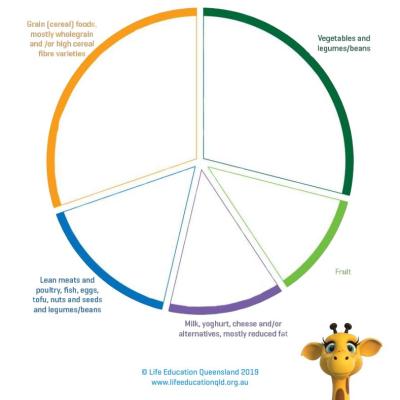 Nutrition: Worksheet
Nutrition: WorksheetAt some stage most parents find it difficult to make sure their child is eating enough fruit and vegetables. But how can you sneak in extra serves while helping your child to understand the importance of making healthy food choices?
Download your FREE tip sheet for ideas on how to get your child to eat more fruit and veggies. An activity sheet is also included to help your child understand the different types of foods they eat.
Neuroscientist Professor Selena Bartlett is an international trailblazer who has been studying the human brain for 30 years. She believes that by understanding how the brain works and how we respond to stress, we can help manage addictive behaviours like drinking, smoking and binge eating.
In this podcast for Life Education Queensland, coinciding with Queensland Mental Health Week, Professor Bartlett explores the link between food and mood, explaining why sugar is an addictive substance and how it changes the physical and chemical structure of the brain.
She also reveals how it’s possible to retrain our mindset through a few simple actions and habits. In other words, just like we tone our bodies at the gym, we can help our brains to become more resilient by changing thoughts, actions and habits that literally form new circuits in the brain.
Professor Bartlett believes that better brain health and fitness is the key to better mental health, and that modern neuroscience has the potential to help millions lead happier healthier lives.
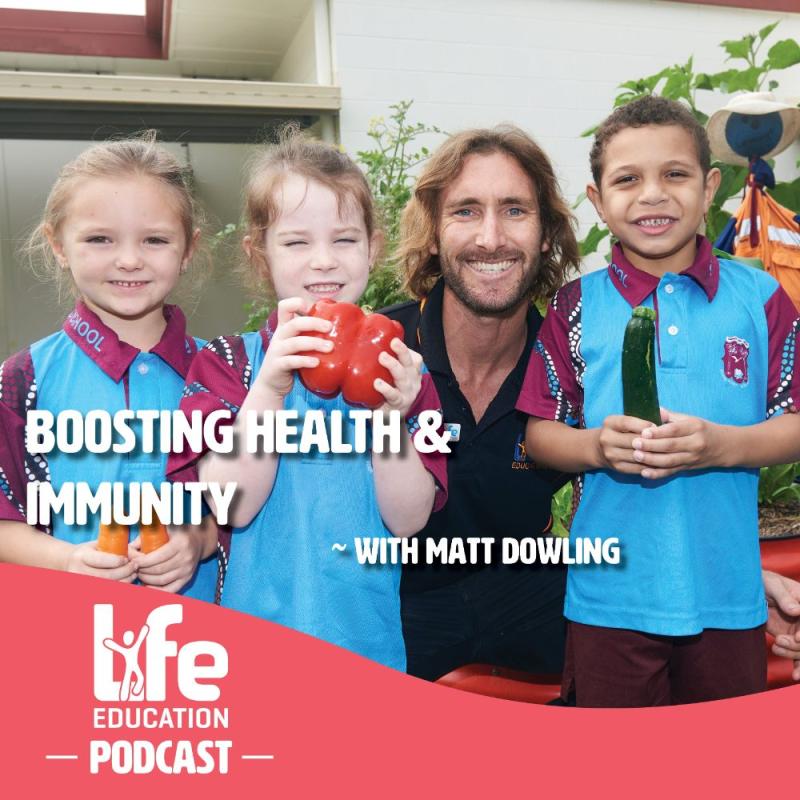
Never have we been more focused on our health and wellbeing than right now, amid a global pandemic.
And whilst no single food or lifestyle can make us immune to COVID-19, there are many things we can do to boost our immunity and stay fit and healthy during the coming months, especially with flu season just around the corner.
In this podcast, host Tracey Challenor chats with Life Education Queensland’s passionate educator and health and nutrition officer Matt Dowling.
From eating well on a budget and encouraging kids to ‘eat a rainbow’ of foods, to changing habits and boosting your mood through exercise, this inspiring chat will leave you feeling positive and motivated to live your best healthy life.
Are you struggling to get your child to eat their greens?
You’re not alone. According to the Australian Bureau of Statistics latest national health survey – 94 per cent of Aussie kids aren’t eating the recommended, two daily serves of fruit and five of vegetables. And more than a quarter of Aussie children aged 5 to 17, are now obese or overweight.
With relentless junk food marketing urging our kids to eat foods high in sugar and fat – and low in fibre and nutritional value – many parents find it a challenge to get their kids to choose the right foods. Tune in to the Life Education podcast and hear popular naturopath and health educator Georgia Harding chat with host Tracey Challenor about good nutrition for kids.
There’s no preaching… just practical fad-free advice for busy parents that will help you get healthier food onto the dinner table and into lunch boxes, and help your kids connect the dots between healthy food and a healthy mind and body.
Just 5% of Australian children consume the recommended amount of vegetables each day. Whilst this might come as a shock, there are simple steps we can all take to increase our fruit and veg intake.
Across the four short webinars below, Life Education Queensland’s Nutrition Officer, Matt Dowling, shares his top tips for healthier eating. Covering everything from reading nutrition labels correctly, to ways to create and model healthy eating habits, this webinar series is not to be missed!